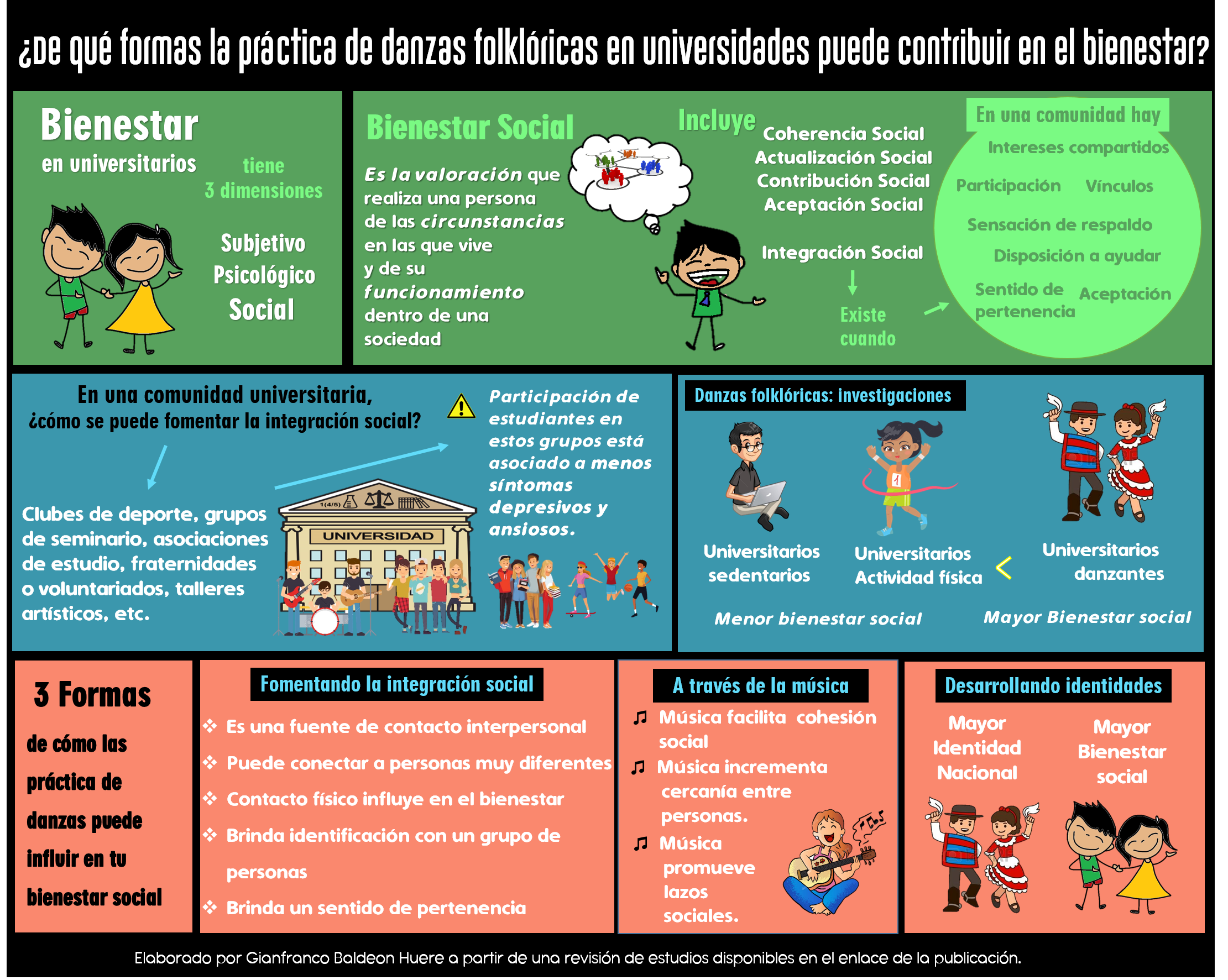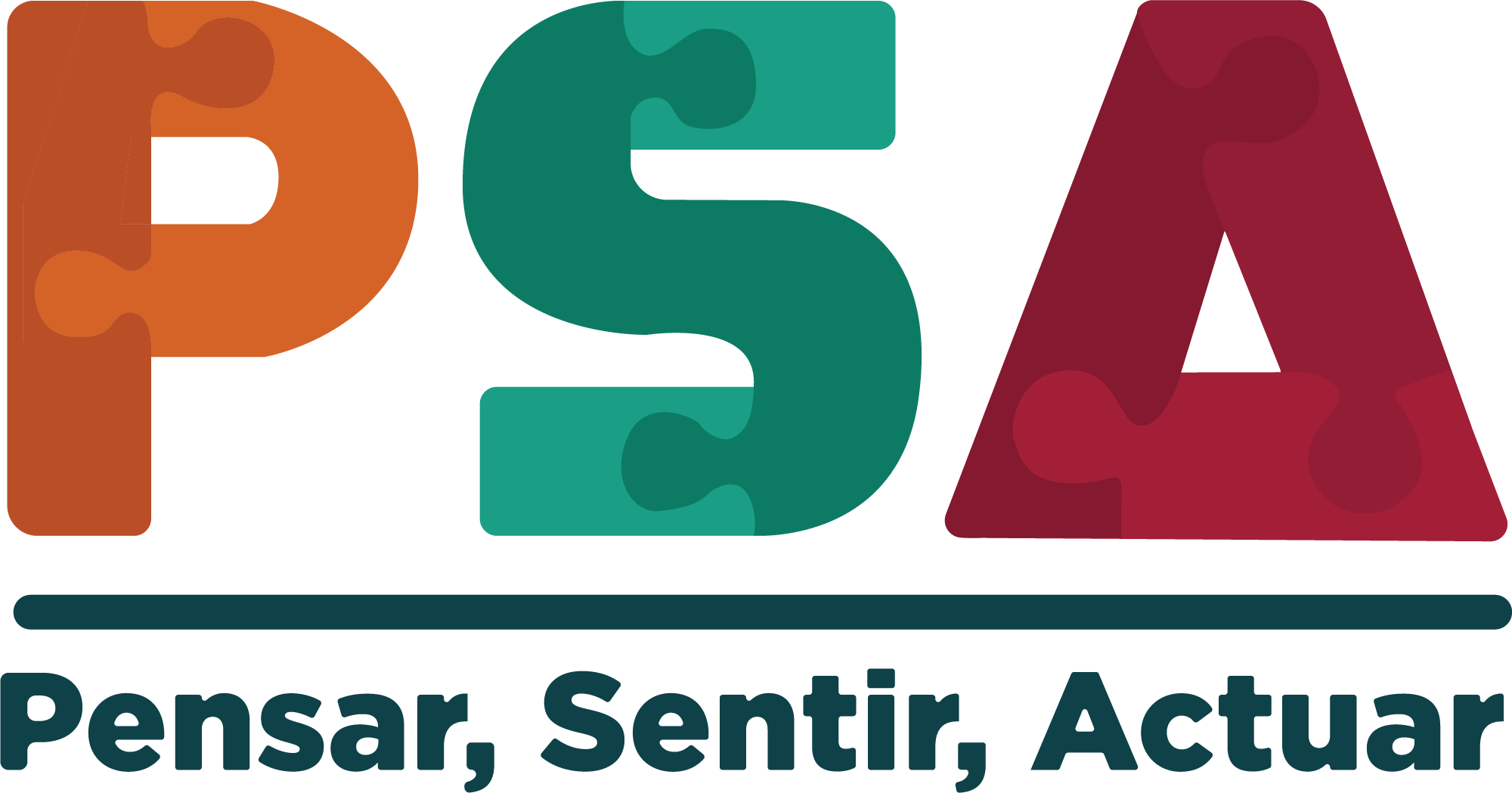Elaborado por Gianfranco Baldeón

Referencias
Allin, L., Coyles, A., & Hayman, R. (2017). Exploring Social Integration of Sport
Students during the Transition to University. Journal Of Perspectives In Applied
Academic Practice, 5(2), 31-36
Barnes, N. (2017). Navigating social integration into university on Facebook: Insights from a longitudinal study. Student Success, 8(1), 1-11. doi:10.5204/ssj.v8i1.362
Bean, J. P. (2005). Nine themes of college student retention. In A. Seidman (Ed.), College student retention. Westport: Praeger Publishers. 215-243. Brooman, S., & Darwent, S. (2013). Measuring the beginning: A quantitative study of the transition to higher education. Studies in Higher Education, 39(9), 1-19. doi:10.1080/03075079.2013.801428
Blanco, A. & Díaz, D. (2005). El bienestar social: su concepto y medición. Psicothema, 17(4), 582-589. Calderan, C. (2012). The Effects of Social Integration on Stress and Risk of Depression in College Students. Perspectives (University Of New Hampshire), 121-128.
Chappell, S. V., & Chappell, D. (2015). Building social inclusion through critical arts-
based pedagogies in university classroom communities. International Journal of Inclusive Education, 20(3), 292-308. doi:10.1080/13603116.2015.1047658
Cueto, R. M., Espinosa, A., Guillén, H., & Seminario, M. (2016). Sentido de Comunidad Como Fuente de Bienestar en Poblaciones Socialmente Vulnerables de Lima, Perú, 25(1), 1-18. Espinosa, A., Beramendi, M., & Zubieta, E. (2015). Identidad nacional y bienestar social: Una síntesis meta-analítica de estudios en Argentina, México y Perú. Revista Interamericana de Psicología, 49(1), 27-39.
Dunbar, R. I. M. (2012). On the evolution of song and dance. In N. Bannan (Ed.), Music, language, & human evolution (pp. 201–214). Oxford, UK: Oxford University Press.
Espinosa, A., Freire, S., & Ferrándiz, J. (2016). Identificación colectiva y bienestar en una comunidad rural de la costa norte del Perú., 34(1), 201-219. Espinosa, A., Soares Da Silva, A., Contreras Ibáñez, C., Cueto, R. M., García Rengifo, A., Ortolano, F., Valencia, J., & Ruíz, Á. V. (2017). Identidad nacional y sus relaciones con la ideología y el bienestar en cinco países de América Latina., 35(2), 351-374.
Espinosa, A. & Tapia, G. (2011). Identidad nacional como fuente de bienestar subjetivo y social. Boletín de Psicología, 102, 71-87.
Forcini, S., Maturo, A., & Ventre, A. G. (2013). The Role of Folk Dance in the Processes of Individual and Social Wellbeing: A Comparison with Other Popular Recreational Activities Through Models of Decision Theory and Game Theory. Procedia Social And Behavioral Sciences, 84(1), 1750.
Gallagher, D., & Gilmore, A. (2013). Social integration and the role of student societies in higher education: an exploratory study in the UK. International Journal Of Nonprofit & Voluntary Sector Marketing, 18(4), 275-286. doi:10.1002/nvsm.1472
Genna, K., & Agustín Espinosa. (2012). Identidad, etnicidad y bienestar social en un contexto socialmente excluyente. Psicologia & Sociedade, 24(1), 84-93.
Herrero, J. & Gracia. E. (2004). Predicting social integration in the community among college students. Journal of Community Psychology. 32 (6): 707-720.
Herrero, J., Fuente, A., & Gracia, E. (2011). Covariates of Subjective well-being among Latin American immigrants in Spain: the role of social integration in the community. Journal of Community Psychology, 39(7), 761-775. doi:10.1002/jcop.20468
Herrero, Juan; Gracia, Enrique; Fuente, Asur; Lila, Marisol; (2012). Desorden social, integración social y bienestar subjetivo en inmigrantes latinoamericanos en España. Anales de Psicología,28(2), 505-514.
Iriarte, F. (2007). Historia de la danza. Lima: Universidad Alas Peruanas, Fondo Editorial Karkou, V., Oliver, S., & Lycouris, S. (2017). The Oxford handbook of dance and wellbeing.
Keyes, C. (1998). Social Well-Being. Social Psychology Quarterly, 61(2), 121-140. http://dx.doi.org/10.2307/2787065
Lampadan, N., & Thomas, D. (2016). The Relationship of Social Integration and Personal Development among University Students in Thailand. Catalyst, 13(1), 74-85.
Manguvo, A. a., Whitney, S., & Chareka, O. (2013). The Role of Volunteerism on Social Integration and Adaptation of African Students at a Mid-Western University in the United States. Journal Of International Students, 3(2), 117-128.
Margrove (2015) Promoting the wellbeing and social inclusion of students through visual art at university: an Open Arts pilot project, Journal of Further and Higher Education, 39(2), 147-162, DOI: 10.1080/0309877X.2013.778967
Merom, D., Cumming, R., Mathieu, E., Anstey, K.J., Rissel, C., Simpson, J.M. (2013). Can social dancing prevent falls in older adults? A protocol of the Dance, Aging, Cognition, Economics (DAnCE) fall prevention randomised controlled trial. BMC Public Health, 13(1), 477.
Open Arts (Noviembre de 2017). About us. Open Arts Project: Essex. Recuperado de http://www.openartsessex.co.uk/about/ Pearce, E., Launay, J., Van Duijn, M.,
Rotkirch, A., David-Barrett, T., & Dunbar, R. I. (2016). Singing together or apart: The effect of competitive and cooperative singing on social bonding within and between sub-groups of a university Fraternity. Psychology of Music, 44(6), 1255-1273. doi:10.1177/0305735616636208
Quiroga, C., & Kreutz, G. (2012). Dance and Health: Exploring Interactions and Implications. In Music, Health, and Wellbeing: Oxford University Press
Rambal, M., Ibáñez, L. & Madariaga, C. (2014). Estudio sobre las estrategias de afrontamiento y el bienestar subjetivo, psicológico y social en mujeres internas en un centro de reclusión femenino del Caribe colombiano (2012). Revista criminalidad, 56(3), 45-57.
Rienties, B. b., Beausaert, S. s., Grohnert, T. t., Niemantsverdriet, S. n., & Kommers, P. P. (2012). Understanding academic performance of international students: the role of ethnicity, academic and social integration. Higher Education (00181560), 63(6), 685-700. doi:10.1007/s10734-011-9468-1
Robles, M. R. A. (2014). Relaciones entre la memoria histórica, la identidad nacional peruana y el bienestar social en jóvenes militares y civiles de Lima (Tesis de Licenciatura). Recuperado de repositorio digital de tesis PUCP.
Savage, P. E., Brown, S., Sakai, E., & Currie, T. E. (2015). Statistical universals reveal the structures and functions of human music. PNAS, 112(29), 8987–8992. Retrieved from http://www.pnas.org/content/112/29/8987.full
Secker, J., Loughran, M., Heydinrych, K., & Kent, L. (2011). Promoting mental well-being and social inclusion through art: evaluation of an arts and mental health project. Arts & Health: International Journal For Research, Policy & Practice, 3(1), 51.
Segrin,C., McNelis, M., & Swiatkowski, P. (2015). Social Skills, Social Support, and Psychological Distress: A Test of the Social Skills Deficit Vulnerability Model. Human Communication Research, 42(1), 122-137.
Secker, J. (2009). Mental health, social exclusion and social inclusion. Mental Health Review Journal, 14(4), 4-11.
Secker, J., S. Hacking, H. Spandler, M. Kent, and J. Shenton. 2007. Mental Health, Social Inclusion and Arts: Developing the Evidence Base. http://www.socialinclusion.org.uk/publications/MHSIArts.pdf?zoom_highlight=secker#search=%22secker%22.
Sosa, F., Fernández, O., & Zubleta, E. (2014). Bienestar social y aculturación psicológica en estudiantes universitarios migrantes. Liberabit: Lima, 20(1), 151-163.
Sooful, A., Surujlal, J., & Dhurup, M. (2013). Dance and music as mediums for the social integration of children with intellectual disabilities into mainstream society. African Journal for Physical, Health Education, Recreation and Dance, 16(4). doi:10.4314/ajpherd.v16i4.64096
Schwarzer, R., Bowler, R. M., & Cone, J. E. (2014). Social integration buffers stress in New York police after the 9/11 terrorist attack. Anxiety, Stress & Coping, 27(1), 18-26. doi:10.1080/10615806.2013.806652
Tapia, G. (2011). Relaciones entre identidad nacional, bienestar subjetivo y social en una muestra de estudiantes de una universidad pública de Lima. 2011. (Tesis de Licenciatura). Recuperado de repositorio digital de tesis PUCP.
Tarr, B., Launay, J., & Dunbar, R. I. M. (2014). Music and social bonding: “Self-other” merging and neurohormonal mechanisms. Frontiers in Psychology, 5, 1096. Retrieved from http://doi.org/doi:10.3389/fpsyg.2014.01096
Vignoles, V., Regalia, C., Manzi, C., Golledge, J. & Scabini, E. (Febrero de 2006). Beyond self-esteem: Influence of multiples motives on identity construction. Journal of Personality and Social Psychology, 90, 308-333.
Wong, Y.-L. I.,&Solomon, P.L. (2002).Community integration of persons with psychiatric disabilities in supportive independent housing: A conceptual model and methodological considerations. Mental Health Services Research, 4, 13–28.
Yañez, C., Mejía, J., & Laca, F. (2012). Identidad mexicana e interés político: Predictores de bienestar social y anomia Identidad mexicana e interés político: Predictores de bienestar social y anomia. Acta Universitaria, 20(2), 40-49.
Zapata Jara, A. A. (2016). Bienestar psicológico y bienestar social en estudiantes universitarios que realizan danzas folklóricas (Tesis de Licenciatura). Recuperado de repositorio digital de tesis PUCP.
Zubieta, E., & Delfino, G. (2010). Satisfacción con la vida, bienestar psicológico y bienestar social en estudiantes universitarios de Buenos Aires. Anuario de Investigaciones, 17(1), 277-283.
Zubieta, E., Fernández, O. & Sosa, F. (2012). Bienestar, valores y variables asociadas. Boletín de Psicología, 106, 7-27.
Zubieta, E., Muratori, M. & Fernández, O. (2011). Bienestar subjetivo y psicosocial: explorando diferencias de género. Salud y sociedad, 3(1), 66 – 76.
